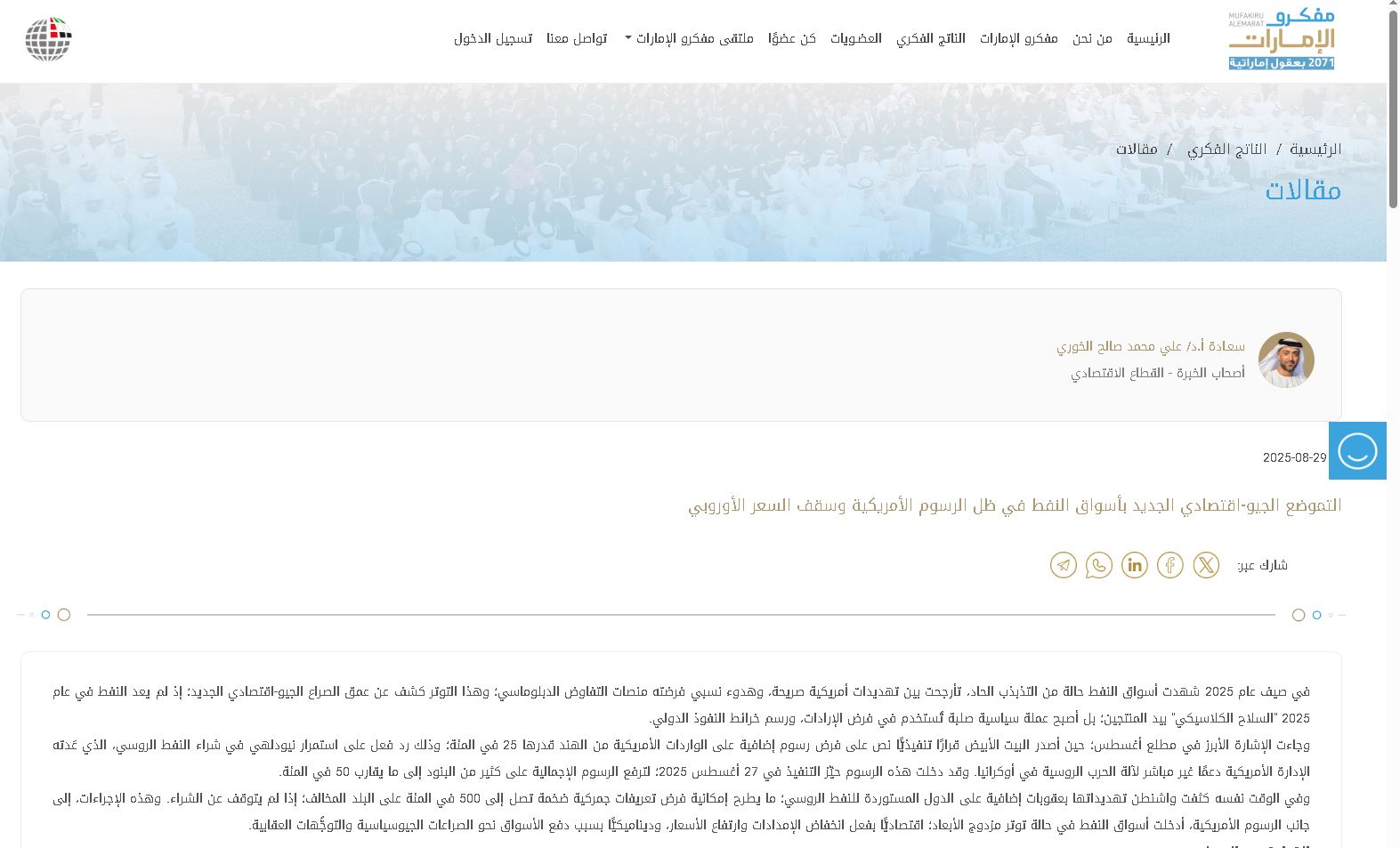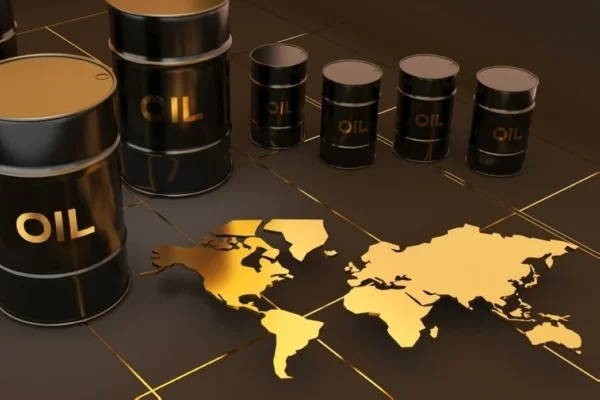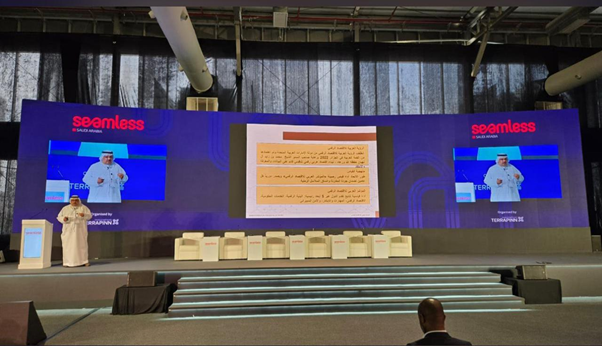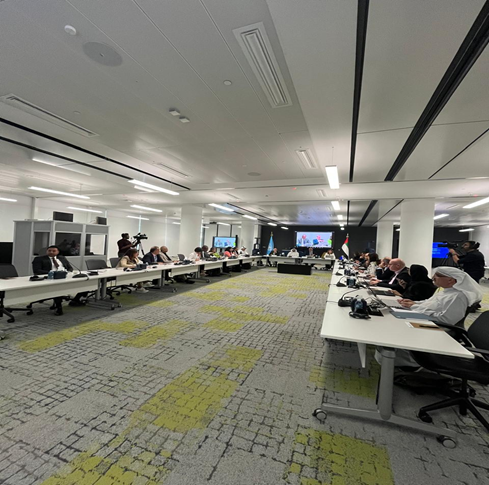Abu Dhabi
Source: Mufakiru Alemarat
Prof. Ali Mohammed Al Khouri
In the summer of 2025, oil markets experienced a period of intense volatility, oscillating between explicit US threats and a relative calm imposed by diplomatic negotiation platforms. This tension revealed the depth of the new geo-economic conflict. In 2025, oil was no longer a “classic weapon” wielded by producers; it had become a solid political currency used to impose wills and chart international influence.
The most notable sign came in early August, when the White House issued an executive order imposing an additional 25 percent tariff on US imports from India. This was in response to New Delhi’s continued purchase of Russian oil, which the US administration viewed as indirect support for the Russian war machine in Ukraine. These tariffs went into effect on August 27, 2025, bringing the total tariffs on many items to nearly 50 percent.
At the same time, Washington has intensified its threats of additional sanctions on countries importing Russian oil, raising the possibility of imposing massive tariffs of up to 500 percent on the offending country if it does not cease purchasing. These measures, coupled with US tariffs, have plunged oil markets into a state of dual tension: economically, due to declining supplies and rising prices, and dynamically, due to geopolitical conflicts and punitive measures pushing markets toward greater risk.
reading between the lines
The American message carried a clear political warning: neutrality in major conflicts will not be a cost-free option. Although the affected countries deemed the American decisions “unfair and unjustified,” this will not change the ideology of the American administration, which treats this issue as a unilateral, unquestionable dictate, leaving the world to bear the consequences of its heavy decisions and pushing markets into a murky maze.
Although the Alaska meeting between Trump and Putin on August 15 offered a temporary glimpse of moderation and demonstrated that the political engine still retains room for dialogue and exchange of positions, far from the logic of complete isolation, it did not close the chapter on the existing tensions. From the perspective of international relations, such meetings may be deliberate preventative tactics aimed at cooling the economic atmosphere, allowing a degree of balance to remain between political stability and the needs of local economies and global markets, preventing them from sliding into uncontrollable chaos.
European pressure tools and pricing policy
Amid this fluid political framework, the European Federation , on July 18, took a new kind of preemptive step. It lowered the Russian price ceiling to $47.6 per barrel, effective September 3, with a semi-annual review mechanism ensuring prices remain approximately 15 percent lower than the market. This clearly indicates that the European market seeks to establish an energy price ceiling that protects its interests, rather than being subject to fluctuations in supply and demand. In addition, it was announced that the import of refined petroleum products from Russian crude via third countries would be prohibited starting January 21, 2026.
Attention has also extended to the vessels transporting these products, with an additional 105 tankers designated as “shadow fleets,” and port, insurance, and maritime services banned to them to prevent attempts at circumvention or legal evasion. These steps are interconnected to produce a regulatory mechanism used to direct and control the market, based on a combination of political influence (such as sanctions or price caps) and technological tools (such as satellite tanker data tracking and cargo monitoring systems) as central pillars for managing oil supplies in the markets.
Brent crude oil price fluctuations
Market and price movements reflected the confusion imposed by the conflicting political signals. Brent crude touched $65 per barrel on August 13, before gradually recovering to around $68-69 by August 25. This price fluctuation cannot be read as an economic equation or explained by traditional market factors alone; rather, it reflects a shift in political tone and diplomatic maneuvering calculations.
“political premium” in price
Oil volatility cannot be understood without understanding the so-called “political risk premium,” the additional portion of the oil price that is not determined by traditional supply and demand laws, but rather by international political and geostrategic security conditions.
If Brent crude oil falls to $65, as some reports indicate, while theoretical estimates (based on the balance between supply and demand and inventories) point to a level between $59 and $60, this difference—the political premium—of $5-6 will reflect concerns about sanctions, tensions in maritime lanes, OPEC+ decisions, and even the tone of political discourse between Washington and Moscow.
In such a scenario, markets will attempt to strike a balance between economic and political realities. If signs of calm appear, the premium may shrink, and the price may decline toward the theoretical level. However, if tensions escalate, or news emerges of new sanctions or a threat to sea lanes, the premium will rise, and the price will jump above its economic value. Arab oil will then become subject to a complex price clock: the price is determined by supply, demand, and inventory, while the premium is determined by political decisions, insurance, financing, and logistics.
Supply and Demand Data: The Economics Behind the Scenes
In light of these interactions, price equations do not appear headed for an absolute escalation, as data from global reports realistically paints the picture. According to the International Energy Agency, global demand growth is estimated at 680,000 barrels per day in 2025 and 700,000 in 2026, bringing consumption to 104.4 million barrels per day.
In contrast, global refineries are experiencing unprecedented operating levels, contributing to a significant improvement in refining margins. Global oil inventories reached approximately 7.836 million barrels in June, while inventories in OECD countries fell to approximately 2.758 million barrels, approaching their lowest levels in the last decade.
This discrepancy indicates that the increase in inventories is no longer concentrated in traditional pricing centers, but rather is distributed across emerging and non-traditional markets, particularly in China, and on ocean carriers outside the Western world. Although this buildup warrants close monitoring, it does not indicate a global supply glut; rather, it reflects a shift in storage locations and the distribution of surplus.
Arab oil independence between economic challenges and geopolitical pressures
The US Energy Information Administration anticipates supply pressure that could lower the average price of Brent to around $58 in the fourth quarter of 2025, and possibly to around $49 in early 2026, before a slow recovery begins, with prices gradually rising. This balance between supply pressure and inventory accumulation on the one hand, and the pressure of sanctions and regulations on the other, places Arab oil in a unique position that requires governments to utilize it wisely, so as not to allow policies that undermine their independence or become a “tool” in the conflict of major powers.
Not all Arab countries are classified as such. Some (such as Saudi Arabia, Iraq, Kuwait, the UAE, Algeria, and Libya) are major exporters whose budgets depend on oil revenues. In contrast, other countries (such as Egypt, Morocco, Jordan, Tunisia, and Lebanon) are net importers and need to cover a large portion of their needs from abroad. This disparity places “Arab oil,” as a comprehensive system, in a dual position; meaning that the Arab world is divided into two opposing factions on opposite sides of the equation, one of which benefits from rising prices, and the other is harmed by them.
Russian resilience coupled with declining revenues
Russia has demonstrated remarkable resilience in distributing its exports, but this is compounded by rising rebates for buyers and gradually declining oil revenues. In June, oil revenues from crude and products fell to approximately $13.57 billion, a decline of approximately 14 percent year-on-year. Crude and product exports could reach approximately 7.3 million barrels per day, representing sustained, but not fatal, pressure on the Russian economy.
India’s purchases of Russian crude oil reached a record high of nearly two million barrels per day in June, while China remains the largest consumer of Russian oil. This situation provides a tactical window for the Arab exporter, but it also carries political risks if the financing and logistics blockade intensifies.
Tactical opportunities for Arab exporters
In this complex context, the direction Arab countries should take is becoming clear. The European tightening of restrictions on refined products made from Russian crude oil will provide the Gulf states, Morocco, Algeria, and Libya with tactical opportunities to enter new markets, particularly in Europe and countries that import diesel and jet fuel. It will also provide a valuable window of opportunity to sign long-term supply contracts at fixed prices before the European restrictions on refined products take effect in January 2026.
This break-even timing could give exporters additional market share. However, to achieve this, coordination within OPEC+ is required to allow for a measured increase in supplies, offer competitive prices that respect surplus limits, and utilize price translation to protect budgets from the potential risks of the market slipping into a price surplus and rising domestic inflation.
Import problems and the cost of switching to the Russian market
For importing Arab countries, reliance on unstable trade routes and temporary, cheap flows via routes not under their direct control could lead to financial surprises if Washington or Europe tightens its grip by imposing tariffs or changing standards.
Moreover, escalating maritime tensions in the Red Sea and the Gulf of Aden have raised insurance premiums from a few dozen cents to nearly a full point in some cases, adding to the burden of the import bill on the currency and reserves. In this case, and if the political premium intersects with logistics and insurance costs, the government price of fuel—which was previously considered partially subsidized—may be surprised to find the treasury lacking its traditional tools (such as subsidies or price fixing). Adopting flexible, periodically adjustable domestic pricing, coupled with social safety nets for targeted groups, represents the best solution proposed to avoid a painful economic crisis.
Collection of readings: politics, market, and legislation
What is different in this climate is that superficial readings of the markets are no longer sufficient; what is required is to read the picture through a triple-layered lens: the political lens that measures the tone of threats and diplomacy; the market lens that measures the balance between supply, demand, and inventory; and the legislative lens that explains how the slightest change in the price ceiling, or legal deadline, can tip the market equilibrium upside down.
Today, Arab oil faces rare and temporary windows of opportunity: Europe, which will require more non-Russian petroleum products; Asia, which is witnessing growing demand for diesel, particularly in India and Southeast Asia; and the political hedging window within OPEC+ for political coordination and maintaining market balance. All of this should be invested rationally and with long-term strategies (with stable supply contracts and market diversification); not with impulsiveness that overwhelms budgets with “short-term opportunities” that could lead to financial volatility or domestic inflation.

Possible scenarios for the coming months
The first scenario is a limited, intermittent escalation that slightly raises market costs, while supply remains stable and the margin retains its political weight in pricing. In this scenario, limited escalation may occur, and the “political risk premium” may reach its upper limit, temporarily pushing the price toward the $65–$70 range. However, as demand continues to decline and inventories rise, Brent will head below $60 in the fourth quarter of 2025 and then toward $50 in 2026, as the International Energy Agency predicts. The market will treat this increase as a temporary bubble, as contract prices remain high despite the weak outlook.
The second scenario concerns the imposition of additional tariffs or sanctions on India and China, which could cut off hundreds of thousands of barrels of Russian oil from the market, temporarily pushing the price toward $70-$75. However, the implementation of these measures would come in the context of a growing global surplus, according to the International Energy Agency and analysts. Therefore, the jump is likely to be short-lived, followed by a settlement to lower levels as additional supplies respond. In other words, the political premium will not last long.
The third scenario is a relative calm that allows the premium to gradually decline. However, demand, offshore availability, and a production surplus will continue to exert negative pressure, causing the price to fall below $55 in early 2026, and possibly below $50 if inventories begin to accumulate at the expected pace. This should exporting countries fail to protect their share or manage the flow in a dynamic and flexible manner.
Arab Future Roadmap
It is not enough for the core component of current Arab policy architecture to be limited to protecting existing oil wealth and capabilities; rather, it must be built on a long-term strategic vision that lays out plans to enable the Arab energy sector to confront market transformations over the next two decades. This vision must be based on foresight in absorbing new globalization tools, such as protective tariffs, ex ante price controls, and political risk premiums.
The central idea of the strategic vision lies in transforming market fluctuations into a sustainable productive force, rather than relying on waves of hasty or ill-considered decisions that waste potential and squander resources. Therefore, today’s Arab oil industries do not need to compete on price alone, but rather require balanced management and an understanding of the “price-risk relationship,” an equation that is difficult for those who do not have a solid understanding of both political rules and financial hedging mechanisms.
The decisive moment does not allow for impulsive reactions. Strategies here cannot be built on emotions, but rather on systematic and coherent tactics that build diplomatic bridges, strengthen ties with influential powers, maintain flexibility for OPEC+ regarding production quotas, treat contract signing as a risk management tool and part of economic policy, and strengthen hedging tools against volatile price trends.
Establishing a backup network for financing and supply is also essential, including diversification of suppliers, multiple contracts (spot, medium, and long-term), a variety of payment currencies, credit lines, insurance, and alternative shipping methods. Reliance on the Russian market should not become a structural dependency, but rather an option within a broader basket.
Consumers must be protected from market shocks through dynamic pricing mechanisms and targeted subsidy programs, which are the most appropriate solution, provided that current political relations do not become the determining factor for fuel prices.











